Chapter: 11th Physics : UNIT 6 : Gravitation
Elementary Ideas of Astronomy
ELEMENTARY
IDEAS OF ASTRONOMY
Astronomy
is one of the oldest sciences in the history of mankind. In the olden days,
astronomy was an inseparable part of physical science. It contributed a lot to
the development of physics in the 16th century. In fact KeplerŌĆÖs laws and
NewtonŌĆÖs theory of gravitation were formulated and verified using astronomical
observations and data accumulated over the centuries by famous astronomers like
Hippachrus, Aristachrus, Ptolemy, Copernicus and Tycho Brahe. Without Tycho
BraheŌĆÖs astronomical observations, KeplerŌĆÖs laws would not have emerged.
Without KeplerŌĆÖs laws, NewtonŌĆÖs theory of gravitation would not have been
formulated.
It
was mentioned in the beginning of this chapter that PtolemyŌĆÖs geocentric model
was replaced by CopernicusŌĆÖ heliocentric model. It is important to analyze and
explain the shortcoming of the geocentric model over heliocentric model.
Heliocentric
system over
geocentric system
When
the motion of the planets are observed in the night sky by naked eyes over a
period of a few months, it can be seen that the planets move eastwards and
reverse their motion for a while and return to eastward motion again. This is
called ŌĆ£retrograde motionŌĆØ of planets.
Figure
6.25 shows the retrograde motion of the planet Mars. Careful observation for a
period of a year clearly shows that Mars initially moves eastwards (February to
June), then reverses its path and moves backwards (July, August, September). It
changes its direction of motion once again and continues its forward motion
(October onwards) . In olden days, astronomers recorded the retrograde motion
of all
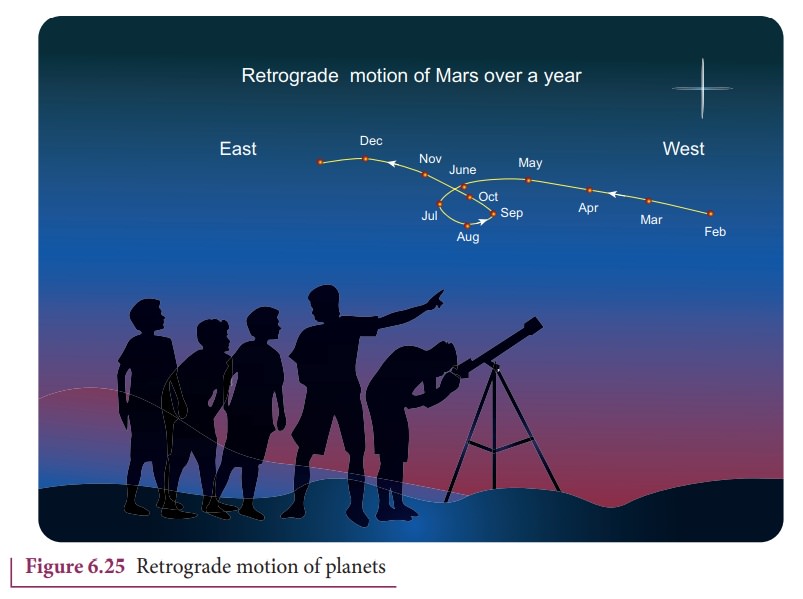
If
it was really a circular orbit it was not known how the planet could reverse
its motion for a brief interval. To explain this retrograde motion, Ptolemy
introduced the concept of ŌĆ£epicycleŌĆØ in his geocentric model. According to this
theory, while the planet orbited the Earth, it also underwent another circular
motion termed as ŌĆ£epicycleŌĆØ. A combination of epicycle and circular motion
around the Earth gave rise to retrograde motion of the planets with respect to
Earth (Figure 6.26). Essentially Ptolemy retained the Earth centric idea of
Aristotle and added the epicycle motion to it.
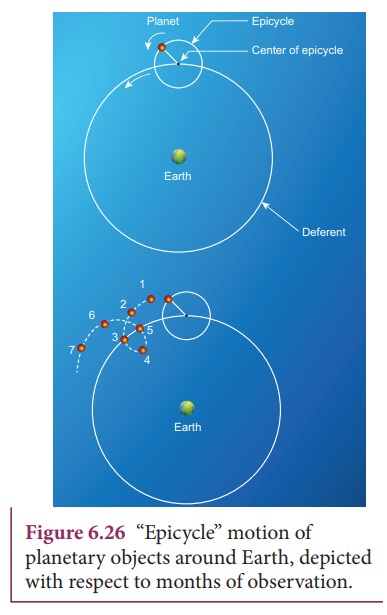
But
PtolemyŌĆÖs model became more and more complex as every planet was found to
undergo retrograde motion. In the 15th century, the Polish astronomer
Copernicus proposed the heliocentric model to explain this problem in a simpler
manner. According to this model, the Sun is at the center of the solar system
and all planets orbited the Sun. The retrograde motion of planets with respect
to Earth is because of the relative motion of the planet with respect to Earth.
The retrograde motion from the heliocentric point of view is shown in Figure
6.27.
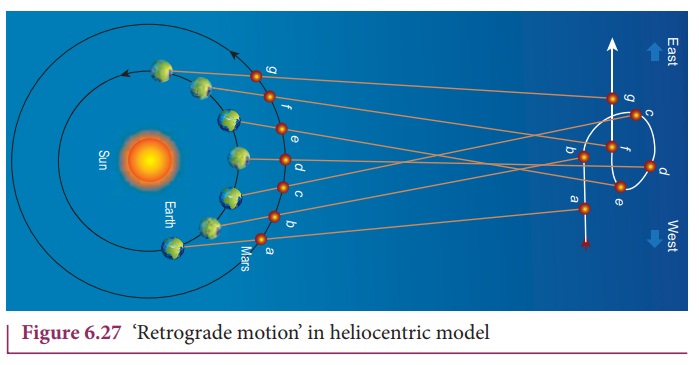
Figure
6.27 shows that the Earth orbits around the Sun faster than Mars. Because of
the relative motion between Mars and Earth, Mars appears to move backwards from
July to October. In the same way the retrograde motion of all other planets was
explained successfully by the Copernicus model. It was because of its
simplicity, the heliocentric model slowly replaced the geocentric model.
Historically, if any natural phenomenon has one or more explanations, the
simplest one is usually accepted. Though this was not the only reason to
disqualify the geocentric model, a detailed discussion on correctness of the
Copernicus model over to PtolemyŌĆÖs model can be found in astronomy books.
KeplerŌĆÖs
Third Law and The Astronomical Distance
When
Kepler derived his three laws, he strongly relied on Tycho BraheŌĆÖs astronomical
observation. In his third law, he formulated the relation between the distance
of a planet from the Sun to the time period of revolution of the planet.
Astronomers cleverly used geometry and trigonometry to calculate the distance
of a planet from the Sun in terms of the distance between Earth and Sun. Here
we can see how the distance of Mercury and Venus from the Sun were measured.
The Venus and Mercury, being inner planets with respect to Earth, the maximum
angular distance they can subtend at a point on Earth with respect to the Sun
is 46 degree for Venus and 22.5 degree for Mercury. It is shown in the Figure
6.28
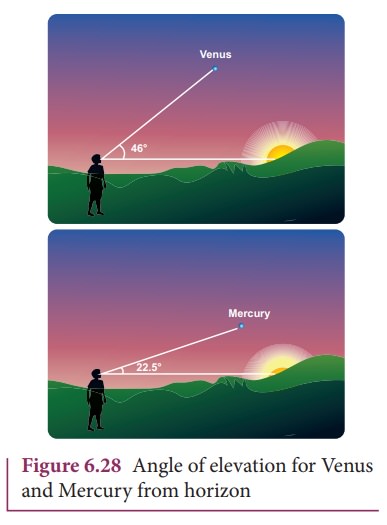
Figure
6.29 shows that when Venus is at maximum elongation (i.e., 46 degree) with
respect to Earth, Venus makes 90 degree to Sun. This allows us to find the
distance between Venus and Sun. The distance between Earth and Sun is taken as
one Astronomical unit (1 AU).
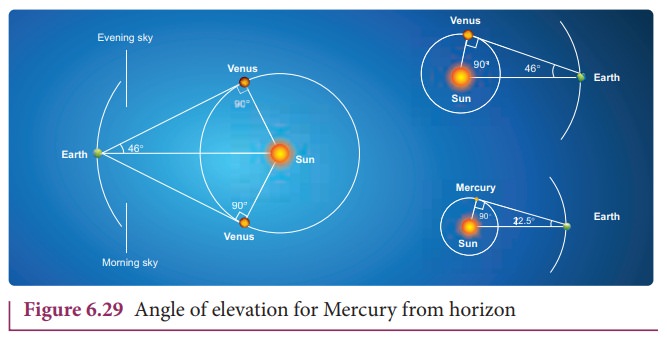
The
trigonometric relation satisfied by this right angled triangle is shown in
Figure 6.29.

Here
sin 46╠Ŗ = 0.77. Hence Venus is at a distance of 0.77 AU from Sun. Similarly,
the distance between Mercury (╬Ė is 22.5 degree) and Sun is
calculated as 0.38 AU. To find the distance of exterior planets like Mars and
Jupiter, a slightly different method is used. The distances of planets from the
Sun is given in the table below.

It
is to be noted that to verify the KeplerŌĆÖs law we need only high school level
geometry and trigonometry.
Measurement of radius of the Earth
Around 225 B.C a Greek librarian ŌĆ£EratosthenesŌĆØ who lived at Alexandria measured the radius of the Earth with a small error when compared with results using modern measurements. The technique he used involves lower school geometry and brilliant insight.
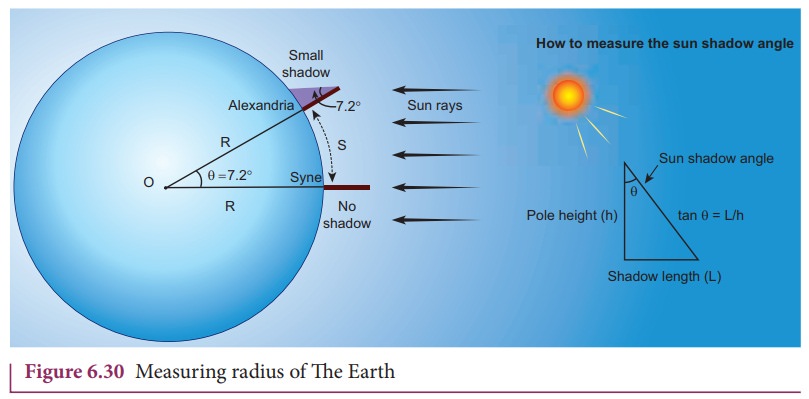
He observed that during noon time of summer solstice the SunŌĆÖs rays
cast no shadow in the city Syne which was located 500 miles away from
Alexandria. At the same day and same time he found that in Alexandria the SunŌĆÖs
rays made 7.2 degree with local vertical as shown in the Figure 6.30. He
realized that this difference of 7.2 degree was due to the curvature of the
Earth.
The
angle 7.2 degree is equivalent to 1/8 radian.
So ╬Ė=1/8 rad;
If
S is the length of the arc between the cities of Syne and Alexandria, and if R
is radius of Earth, then
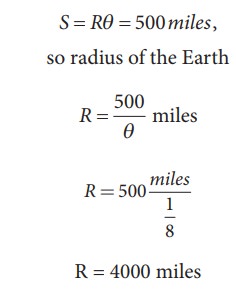
1 mile is equal to 1.609 km. So, he measured
the radius of the Earth to be equal to R = 6436 km, which is amazingly close to
the correct value of 6378 km.
The
distance of the Moon from Earth was measured by a famous Greek astronomer
Hipparchus in the 3rd century BC.
Interesting Astronomical Facts
1. Lunar eclipse and measurement of shadow of Earth
On
January 31, 2018 there was a total lunar eclipse which was observed from
various places including Tamil Nadu. It is possible to measure the radius of
shadow of the Earth at the point where the Moon crosses. Figure 6.31
illustrates this.
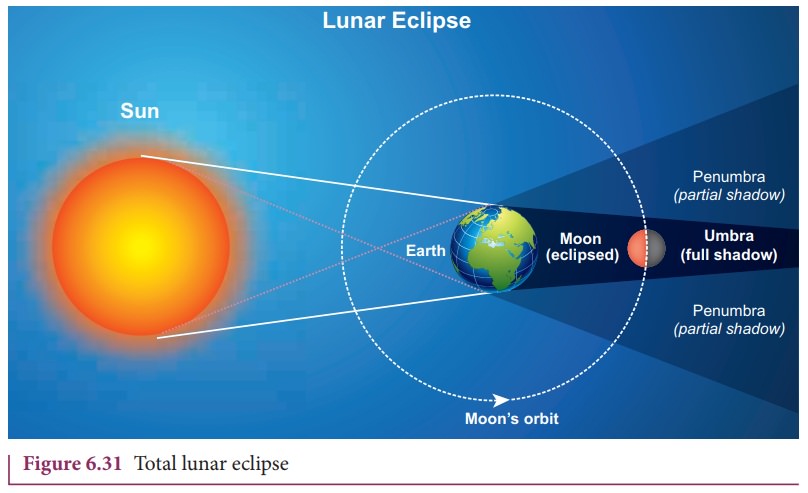
When the Moon is inside the umbra shadow, it appears red in color. As soon as the Moon exits from the umbra shadow, it appears in crescent shape. Figure 6.32 is the photograph taken by digital camera during MoonŌĆÖs exit from the umbra shadow.
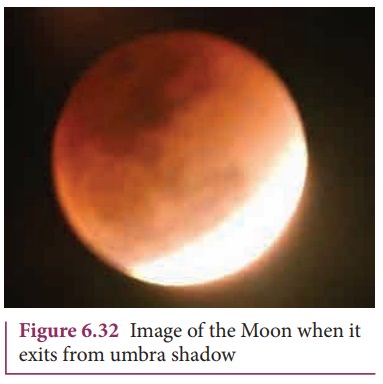
By finding the apparent radii of the EarthŌĆÖs umbra shadow and the Moon, the ratio of the these radii can be calculated. This is shown in Figures 6.33 and 6.34.
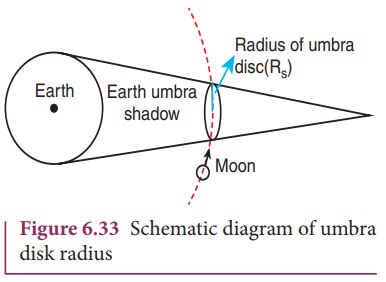
The
apparent radius of EarthŌĆÖs umbra shadow = Rs = 13.2 cm
The
apparent radius of the Moon = Rm= 5.15 cm
The
ratio Rs/Rm Ōēł 2.56
The
radius of the EarthŌĆÖs umbra shadow is Rs
= 2.56 x Rm
The
radius of Moon Rm = 1737 km
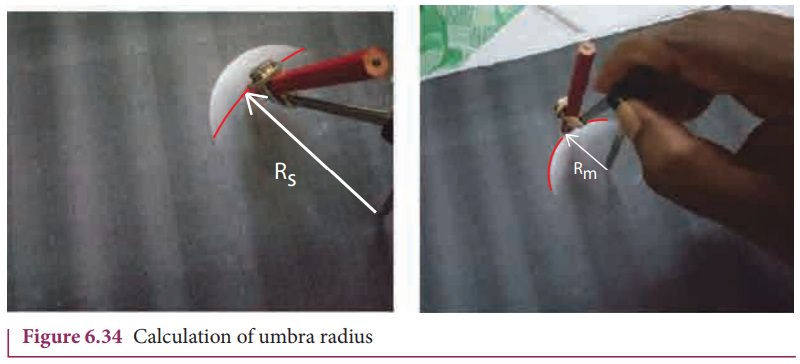
The
radius of the EarthŌĆÖs umbra shadow is Rs = 2.56x1737km ~ŌēĪ4446 km.
The
correct radius is 4610 km.
The
percentage of error in the calculation = [ (4610 ŌĆō 4446) / 4610 ] x 100 = 3.5%
.
The
error will reduce if the pictures taken using a high quality telescope are
used. It is to be noted that this calculation is done using very simple
mathematics.
Early astronomers proved that Earth is
spherical in shape by looking at the shape of the shadow cast by Earth on the
Moon during lunar eclipse.
2. Why there are no lunar eclipse and solar eclipse every month?
If the orbits of the Moon and Earth lie on the same plane, during full Moon of every month, we can observe lunar eclipse.
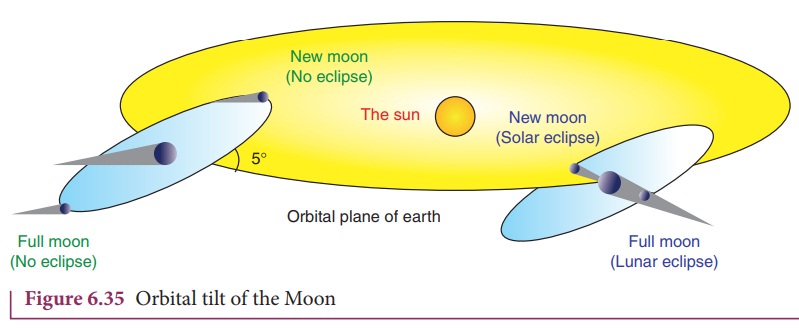
If this is so during new Moon we can observe
solar eclipse. But MoonŌĆÖs orbit is tilted 5┬░ with respect to EarthŌĆÖs orbit. Due
to this 5┬░ tilt, only during certain periods of the year, the Sun, Earth and
Moon align in straight line leading to either lunar eclipse or solar eclipse
depending on the alignment. This is shown in Figure 6.35
3. Why do we have seasons on Earth?
The common
misconception is that ŌĆśEarth revolves around the Sun, so when
the Earth is very far away, it is winter and when the Earth is nearer, it is
summerŌĆÖ.
Actually,
the seasons in the Earth arise due to the rotation of Earth around the Sun with
23.5┬░ tilt. This is shown in Figure 6.36
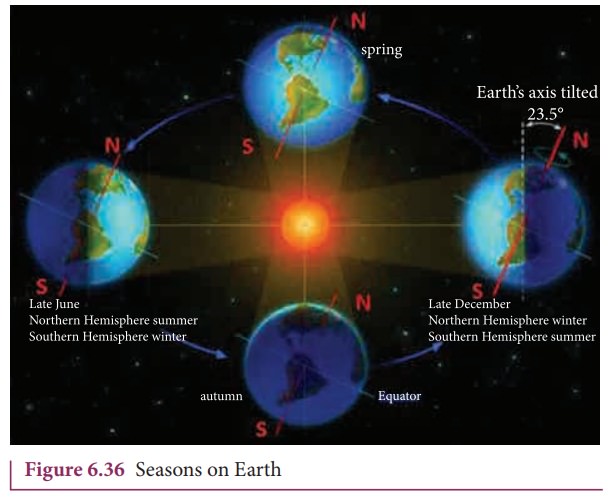
Due to this 23.5┬░ tilt, when the northern part of Earth is farther to the Sun, the southern part is nearer to the Sun. So when it is summer in the northern hemisphere, the southern hemisphere experience winter.
4. StarŌĆÖs apparent motion and spinning of the Earth
The
EarthŌĆÖs spinning motion can be proved by observing starŌĆÖs position over a
night. Due to EarthŌĆÖs spinning motion, the stars in sky appear to move in
circular motion about the pole star as shown in Figure 6.37
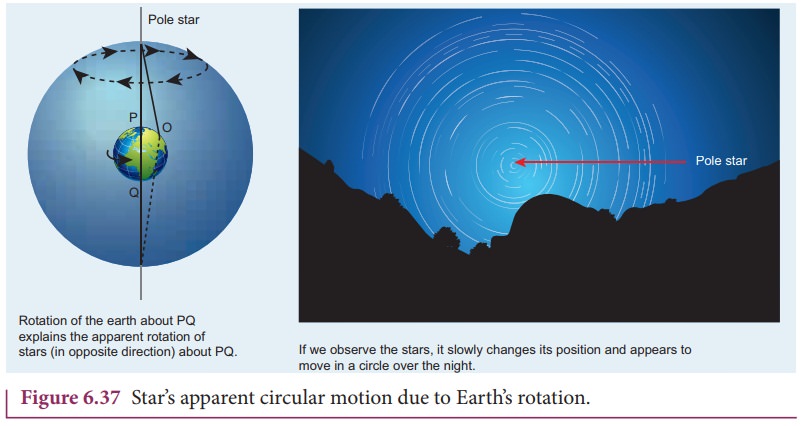
Recent
developments of astronomy and gravitation
Till
the 19th century astronomy mainly depended upon either observation with the
naked eye or telescopic observation. After the discovery of the electromagnetic
spectrum at the end of the 19th century, our understanding of the universe
increased enormously. Because of this development in the late 19th century it
was found that NewtonŌĆÖs law of gravitation could not explain certain phenomena
and showed some discrepancies. Albert Einstein formulated his ŌĆśGeneral theory
of relativityŌĆÖ which was one of the most successful theories of 20th century in
the field of gravitation.
In
the twentieth century both astronomy and gravitation merged together and have
grown in manifold. The birth and death of stars were more clearly understood.
Many Indian physicists made very important contributions to the field of
astrophysics and gravitation.
Subramanian
Chandrasekar formulated the theory of black holes and explained the life of
stars. These studies brought him the Nobel prize in the year 1983. Another very
notable Indian astrophysicist Meghnad Saha discovered the ionization formula
which was useful in classifying stars. This formula is now known as ŌĆ£Saha
ionization formulaŌĆØ. In the field of gravitation Amal Kumar Raychaudhuri solved
an equation now known as ŌĆ£Raychaudhuri equationŌĆØ which was a very important
contribution. Another notable Indian Astrophysicist Jayant V Narlikar made
pioneering contribution in the field of astrophysics and has written
interesting books on astronomy and astrophysics. IUCAA (Inter University Center
for Astronomy and Astrophysics) is one of the important Indian research
institutes where active research in astrophysics and gravitation are conducted.
The institute was founded by Prof. J.V. Narlikar. Students are encouraged to
read more about the recent developments in these fields.
Related Topics